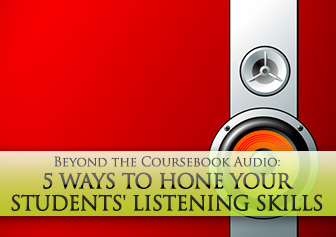ESL Coursebook Listening Tasks: 6 Steps to Make the Most of Them


In fact, I use it quite often. But it’s so predictable. Students are familiar with the crisp, clear pronunciation. They know exactly what to expect in terms of exercises: Listen and repeat. Listen and answer the questions. And so it goes. They also know the conversation they’ll listen to will include mostly vocabulary and grammar they know. No surprises there.
Sometimes, you need to step away from the CD player and give your students listening practice that goes beyond the audio material that comes with the coursebook. If your students’ level allows it, you should give them real audio from authentic sources, not just those that cater to ESL students. So if you really want to hone your students’ listening skills, here are 5 ways to go about this daunting task.

This is a great strategy you can use to fine tune your students’ listening. Choose an audio or video segment that clearly answers these four questions. Here’s a great example from Newsy. Start with a warm up to introduce the topic: What are some reasons why a concert or event might be cancelled? Next, introduce any words that may be new to students. Play the video once so students may get the gist or main idea. Finally, tell students they will watch a news segment and all they have to do is listen carefully and be prepared to answer these four questions.
This is a great approach to use with interviews. Find an audio track or video segment with an interview – it can be anyone from a famous celebrity to a local doctor. The important thing is for the interview to be clear and appropriate for your students’ level. After going through the warm up and introduction of new vocabulary, tell students that they will listen to an interview.
For the first listening, ask them to write down the questions asked. Now, they don’t have to write every question word for word, just the main idea. For example, if the interviewer asks, “Where are you from?” students may simply write “birthplace” or “nationality”. For the second listening, students should take notes on the responses to these questions, and yes, notes, not full answers. Remind students that this is a listening exercise not grammar practice.
Students then take turns asking each other the same questions and giving the same responses as the person interviewed. If the student asking the question thinks that the other student’s response is wrong he/she may call him/her on it and demand a replay of the audio/video to confirm that indeed that is not what the person said.
This technique puts not only your students’ listening skills to the test but also their thinking caps on. Choose a conversation to have them listen to, one where opposites may be applied. For example, if the conversation mentions good weather conditions, the opposite would be bad weather conditions. After going through a warm up and introduction of new vocabulary, play the conversation for students to listen to. Play it a second time and instruct students to think of opposites for some of the words. Divide students into pairs and have them recreate the conversation but saying the opposite of what was originally said.
If the conversation started with I had the most awful day yesterday, students must start by saying, I had the best day yesterday.
Another strategy that always works in listening comprehension activities is having students check to make sure they understood correctly. Find an audio file that sets forth a set of instructions. For example, a You Tube how to video. Play the video for the class. Then have a student repeat the instructions/steps to make sure they got them right. Other students may raise their hands if they notice a discrepancy.
This is another strategy that is guaranteed to boost students’ listening skills. Play a conversation, but leave out the part where they mention a key aspect. For example, say the conversation starts with someone saying where they went on vacation and then going on to describe in detail where they went. Start the audio after they mention the name of the place they went to. Students will only hear the description of activities. And based on the part of the conversation they do hear, they will have to infer that key piece of missing information.
Example:
Man: How was your vacation, Karen?
Woman: It was great! We went to Rome and saw some stunning art and architecture. We went to the Coliseum and visited the Vatican. They have some breathtaking art in there. Then we went to several smaller churches and museums. All in all, it was a wonderful vacation, everything I’d hoped it would be.
Play the audio to start from We went to the Coliseum…. Students have to listen carefully and figure out the speaker went to Rome.
Challenge them to really put their listening skills to the test.
Which types of audio do you like to use besides de coursebook audio? Share below!